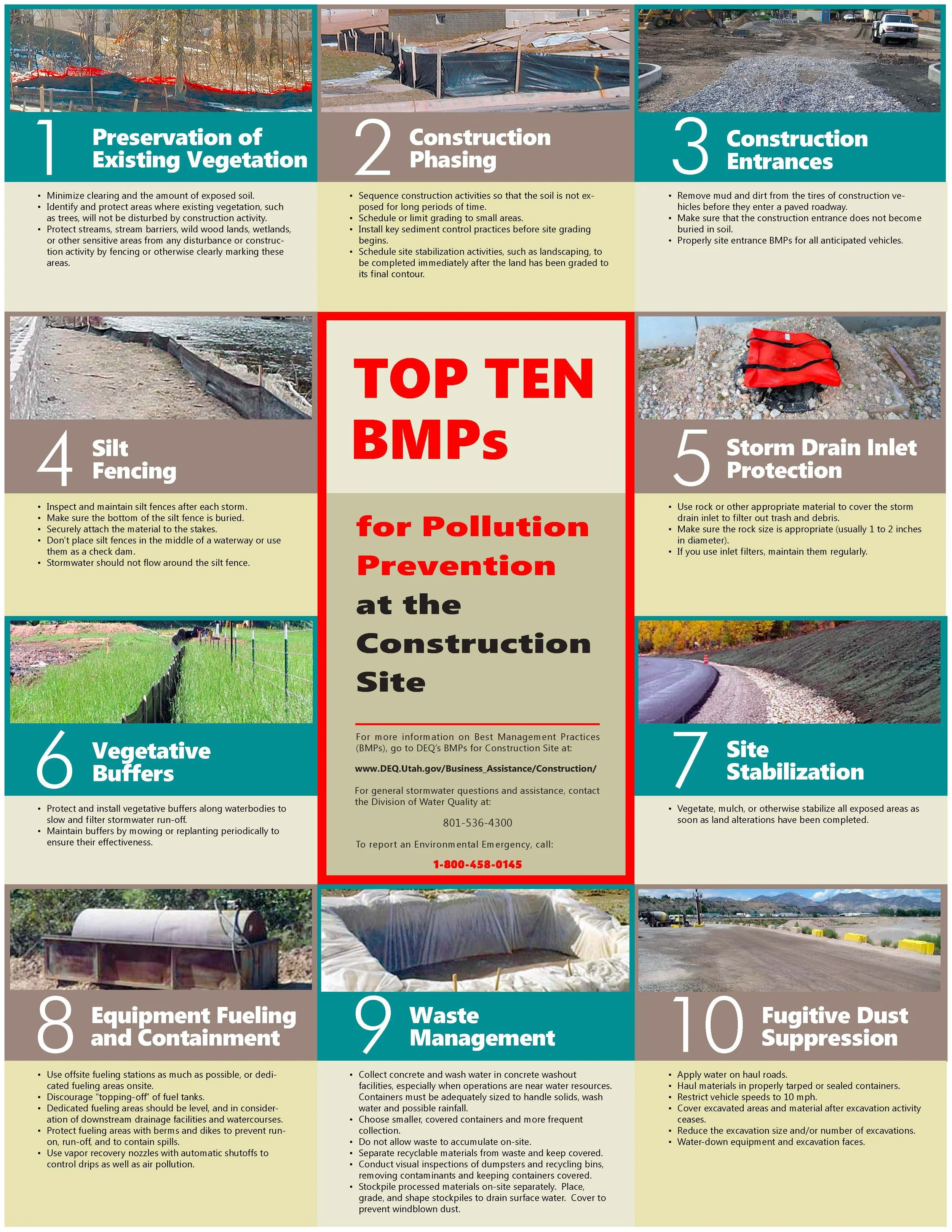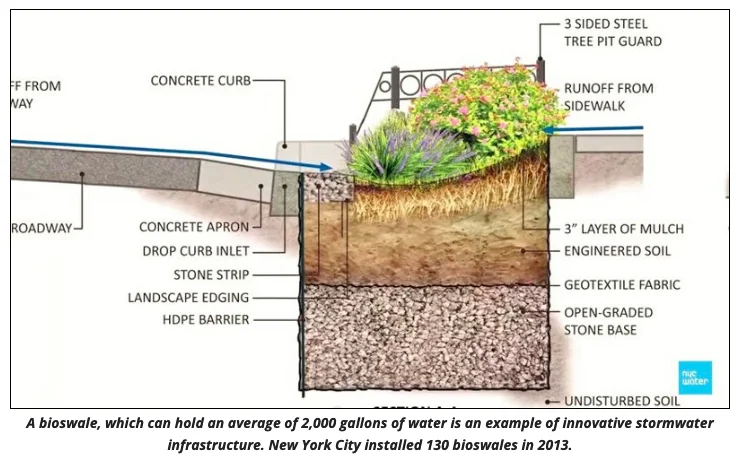Contractors and Developers
Building communities and maintaining water quality.
In the state of Utah, contractors and developers are required to be in compliant with stormwater regulations. Through implementing a Stormwater Pollution Prevention Plan (SWPPP) it ensures the construction project will minimize stormwater pollution. Construction sites are a well-known source of sediment and other pollutants which can cause significant harm to local water quality and flood control facilities.
Salt Lake County Stormwater Coalition offers trainings to maintain or be compliant when it comes to keeping the water clean. If the construction UPDES stormwater permits disturbing one or more acre of land, it is required.
Utah Best Management Construction Practices (poster from Utah DEQ)
TOP-OF-MIND for CONTRACTORS, Developers & Stormwater :
1- Obtain and comply with General Construction Permit (Utah DWQ)
https://deq.utah.gov/water-quality/general-construction-storm-water-updes-permits
2- Develop a daily practice of Controlling Construction Stormwater Discharges. Everyone on the job can help to prevent stormwater pollution by adopting these practices:
● Design, install, and maintain effective erosion and sediment controls, and pollution prevention measures, to minimize the discharge of pollutants;
● Stabilize disturbed areas immediately when construction has ceased and will not resume for more than 14 days;
● Prohibit the dewatering discharges unless managed by appropriate controls;
● Prohibit the discharge of: Wastewater from concrete washout or washout/cleanout of stucco, paint, form release oils, other wastewater materials; Fuels, oils, or other pollutants used for vehicles; and soaps or solvents to wash vehicles and equipment.
Why should contractors and developers implement a Stormwater Pollution Prevention Plan (SWPPP) at construction sites?
Required by Law: Before construction can begin, Site Construction Managers must obtain a National Pollutant Discharge Elimination System (NPDES) Construction General Permit (CGP) for stormwater discharge (EPA 2007). A CGP requires developers and contractors to implement a SWPPP to enforce sediment and erosion control at construction sites. The U.S. Environmental Protection Agency (EPA) and state agencies can impose fines if an SWPPP is not carried out.
Reputation: Developers and Contractors with good reputations continue to gain work in the future as they build trust with the community and with State and Federal Agencies. Planning authorities, City Council, and local community groups want to know that Developers and Contractors are knowledgeable about and capable of using the Best Management Practices (BMPs) laid out in the SWPPP. Developers and Contractors who create a quality product by using BMPS to conserve and protect the local environment become trusted partners in the community (Pitt, 2004).
Avoid Fines, Shutdowns, and Litigation: Construction Site Operators (CSOs) can avoid fines that might accrue by not following the proper procedures. CSOs can stay within their proposed timeline by avoiding shutdowns and litigation (EPA 2007).
Save Time and Money: Most environmentally responsible BMPs save contractors time and money. The initial investment in materials and labor likely benefits in a greater payoff post construction (Pitt 2004).
Do the Right Thing: No matter how big or small a potential project might be, knowing that it was done in a manner that considered the natural environment and contributed to the community in a positive way always feels good, keeps your business in compliance and helps you to maintain a positive business reputation in the communities in which you are building and developing.
Illustration of Hydroseeding
Photo credit: Turf Magazine
VIDEO RESOURCES
NRPA and APA demonstrate the benefits of green infrastructure in urban communities. Using parks for green infrastructure is a creative and cost-effective alternative to gray infrastructure that allows nature to filter pollutants from rain water, reduce storm water issues and give communities access to more green space.
Information about Low Impact Development (LID)
The key premise of low impact development (LID) is to allow natural systems to manage stormwater when and wherever possible. LID takes advantage of existing natural features and also designs and constructs systems to imitate natural processes, for example, green roofs, bioretention gardens, and permeable pavement. Historically, stormwater management meant stormwater disposal. With LID, stormwater is managed as a resource rather than a liability. LID's goal is to mimic a site's natural capability to handle stormwater by using design techniques that infiltrate, filter, store, evaporate, and detain runoff close to its source. LID was pioneered in Maryland in 1985 to address economic and environmental issues associated with water quality concerns in Chesapeake Bay. Since then, the concept of LID has been implemented to varying degrees nationwide. Projects in Nebraska and the region are being designed and installed in growing numbers as the concept becomes more accepted.
Low impact development helps manage both stormwater quality and quantity.
Quantity concerns include flooding and property damage, damage to stream channels, lower stream base flows, and less groundwater recharge.
Water quality concerns arise when stormwater runoff collects sediments, nutrients, acids and salts, heavy metals, toxic chemicals, and pathogens. Increased water temperature is also a major water quality concern.
LID is effective. It results in landscapes that generate less surface runoff, less pollution, less erosion, and less overall damage to lakes, streams and coastal waters.
LID can be economical. It can cost less to construct and maintain than conventional stormwater management systems while enhancing environmental quality and quality of life.
LID is flexible. It offers a wide variety of techniques to provide for both runoff quality and quantity benefits.
LID is a balanced approach. LID is ecologically-based land development that seeks to better integrate the built environment with the natural environment.
See an example cross-section of a bioswale in New York installed in 2013, below.
Trainings + Resources available
Utah Construction Stormwater Pollution Permit and Fee information
Stormwater Tip Sheet for Business: Construction Crews (September 2022) (customizable) (pptx) (512.47 KB)
Stormwater Tip Sheet for Business: Construction Crews (September 2022) (pdf) (4.11 MB)
Top 5 Construction Site Stormwater Permit Violations (flyer by MPCA )
Operation and Maintenance of Green Infrastructure Receiving Runoff from Roads and Parking Lots




